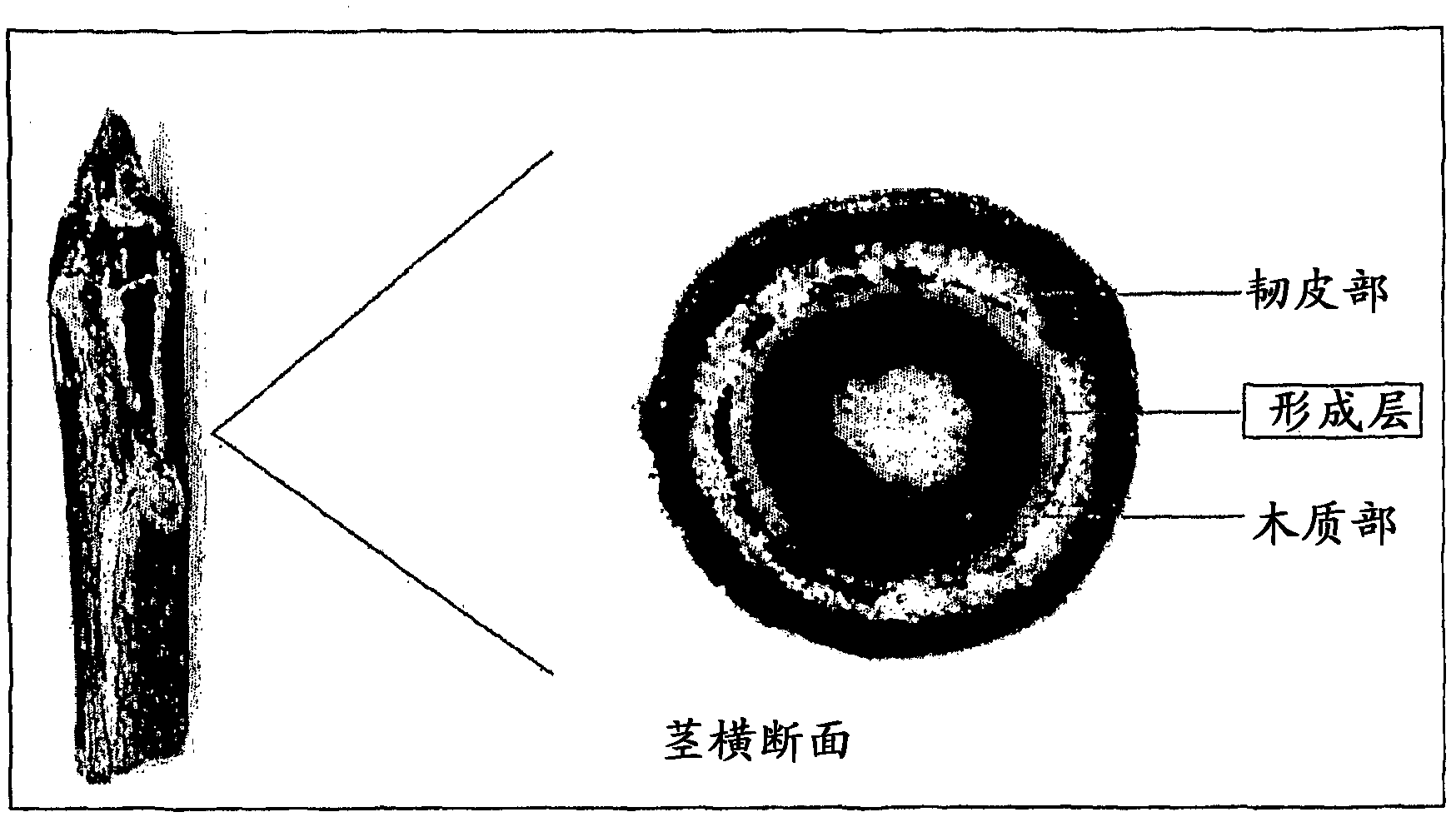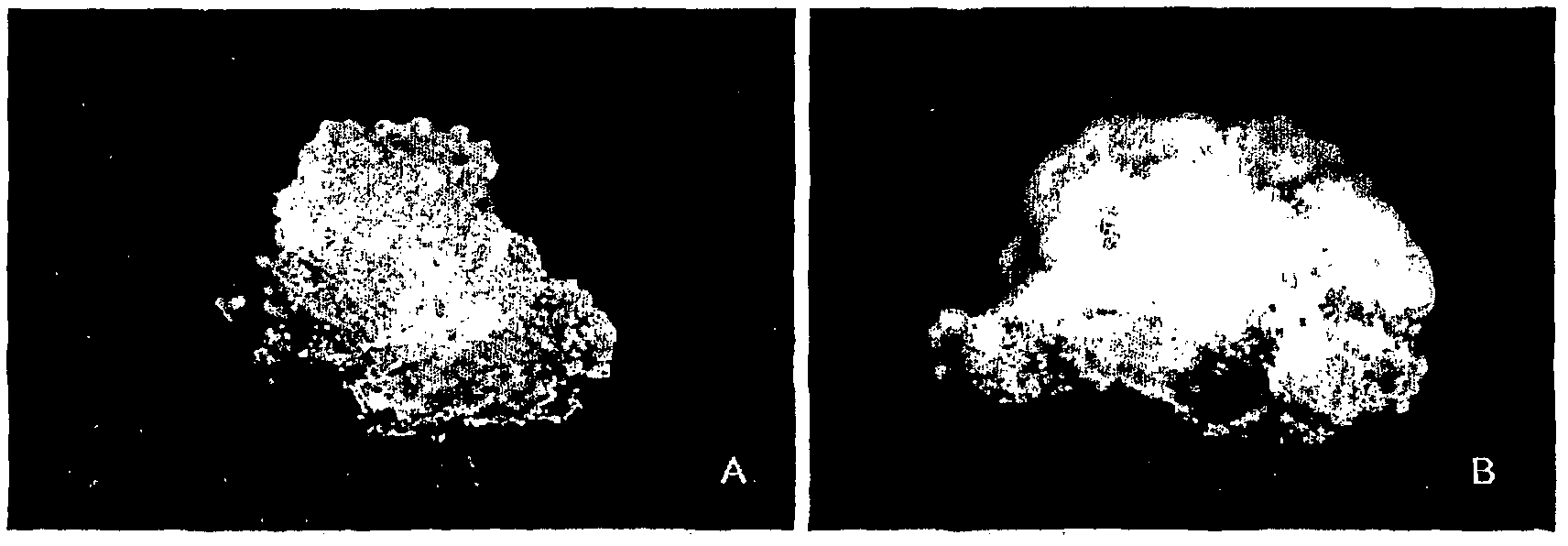Plant stem cell derived from cambium of family gingkoaceae and method for isolation thereof
A ginkgoaceae and cambium technology, applied in the field of stem cells and their separation, can solve problems such as variation, high production costs, and complex chemical structures
- Summary
- Abstract
- Description
- Claims
- Application Information
AI Technical Summary
Problems solved by technology
Method used
Image
Examples
Embodiment 1
[0065] [Example 1: Preparation of stem cells derived from cambium of Ginkgoaceae]
[0066] 【1-1: Preparation of plant materials】
[0067] Ginkgo biloba (Ginkgo biloba, Buyeo, Chungcheongnam-do, South Korea) of the genus Ginkgo in the Ginkgo family such as figure 1 , The xylem and phloem fibers can be observed by staining with phloroglycinol, and it can be confirmed that there is a cambium therebetween. To harvest the cambium-derived stem cells from such ginkgo biloba, the stem cells of the ginkgo biloba were first collected and immediately immersed in an antioxidant 100 mg / L ascorbic acid (L-ascorbic acid, DUCHEFA, The Netherlands) solution for delivery and storage. At this time, to harvest the same stem cells for utilizing the procambium, the residual branches were collected instead of the stems.
[0068]Thereafter, in 1% benomyl (benomyl, Dongbu Hannong Chemical, Korea), 1% chlorothalonil (daconil, Dongbu Hannong Chemical, Korea), 1% streptomycin sulphate (duchefa, The Net...
Embodiment 2
[0078] [Example 2: Proliferation and characteristic observation of stem cells derived from the cambium of the genus Ginkgo]
[0079] The cambium-derived stem cells isolated in Example 1 were placed in a bottle containing the following liquid medium and cultured in a shaker at 100 rpm at 25±1° C. under dark conditions. The cycle of subculture is fixed at 2 weeks, so that the cultured cells can always maintain high viability in the logarithmic growth phase.
[0080] Table 2: Suspension medium (medium 2)
[0081]
[0082] When observing the degree of cell aggregation (biological microscope C × 31, Olympus, Japan), the stem cells according to the present invention are as follows: Figure 4 As shown in A, it was confirmed that a large number of single cells were included in the suspension culture, and some of them existed as small-sized cell aggregates. ,Such as Figure 4 As shown in B, agglutination can be observed.
[0083] On the other hand, if Figure 5 As shown in A, ...
Embodiment 3
[0099] [Example 3: Treatment of elicitors and preparation of extracts from cambium-derived stem cells of Ginkgo biloba]
[0100][3-1: Handling of elicitors]
[0101] Stem cells cultured in suspension for 14 days as in Example 2 were collected and divided into two treatment groups to carry out the experiment. That is, (1) the 14-day suspension-cultured cell line (growth phase), (2) the 14-day suspension-cultured cell line was added to sterilized water with 3 to 5% by weight (g / L ) and methyl jasmonate 100 μM culture medium in the dark for 14 days (induction phase).
[0102] [3-2: Preparation of extract]
[0103] After the culture medium was removed from each of the two cell lines, 2 g of the freeze-dried freeze-dried cell line (Dry) was dissolved by stirring with 50 ml of 80% ethanol at 15° C. for 48 hours. After the dissolution, the extract powder obtained by centrifuging at 3,000 rpm for 20 minutes and freeze-drying the supernatant was dissolved in PBS, and the ethanol ext...
PUM
 Login to View More
Login to View More Abstract
Description
Claims
Application Information
 Login to View More
Login to View More - R&D
- Intellectual Property
- Life Sciences
- Materials
- Tech Scout
- Unparalleled Data Quality
- Higher Quality Content
- 60% Fewer Hallucinations
Browse by: Latest US Patents, China's latest patents, Technical Efficacy Thesaurus, Application Domain, Technology Topic, Popular Technical Reports.
© 2025 PatSnap. All rights reserved.Legal|Privacy policy|Modern Slavery Act Transparency Statement|Sitemap|About US| Contact US: help@patsnap.com



